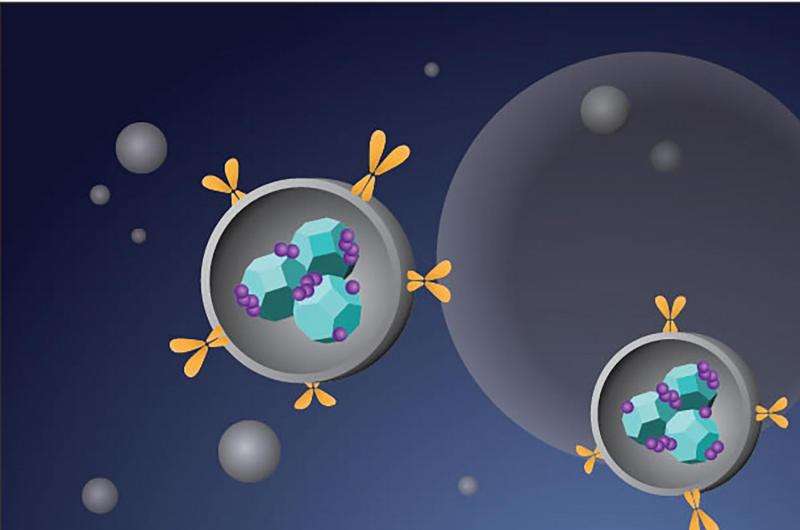August 25, 2015 report
Research trio outlines ways nanodiamonds are being used to treat cancer

(Phys.org)—A trio of researchers, Dean Ho, with UCLA in the U.S., Chung-Huei Katherine Wang, with BRIM Biotechnology Inc., in Taipei and Edward Kai-Hua Chow with the National University of Singapore, has published a review in Science Advances, of the ways nanodiamonds are being used in cancer research and offer insights into the ways they may be used in the future.
As the research trio note, significant progress has been made over the past several decades in the development of nano-materials for use in treating cancer and other ailments. The central idea is to use very tiny particles to carry tumor fighting drugs to tumors (they are not as easily repelled as the larger varieties) thereby healing the patient. The list includes metallic particles, nanotubes, polymers and even lipids. More recently, scientists have been looking into using nanodiamonds as more is learned about the electrostatic capabilities of their facet surfaces when they carry chemicals in a biological system, the ways their inert core can be useful in certain applications and as a means to capitalize on their tunable surfaces.
The authors note that nanodiamonds used in medical applications fall into two main categories, detonation nanodiamonds (DNDs) and fluorescent nanodiamonds (FNDs) as part of highlighting the major ways that nanodiamonds are currently being used:
Imaging—both DNDs and FNDs, the researchers note are increasingly being eyed as a way to improve magnetic resonance imaging and more recently FNDs are also being seen as a way to track stem cells to learn more about their regenerative potential.
Drug Delivery—a lot of research is currently going on to learn more about which types of drugs adhere well to nanodiamond facets, most specifically those used in chemotherapy applications.
Biodistribution and Toxicity—similarly, a lot of research is being conducted to learn more about the ways nanodiamonds can be placed into a living organism (injection, consumption, though the skin, etc.) and whether there is a danger of toxicity.
The researchers note that another area of study involves using nanodiamonds as part of drug testing—if medications can be carried to specific sites, they note, there might be less side-effects.
Another benefit of using nanodiamonds, they note, is that despite being associated with precious gems, nanodiamonds would be quite cheap to procure and use because they can be obtained from mining waste.
More information: Nanodiamonds: The intersection of nanotechnology, drug development, and personalized medicine, Science Advances 21 Aug 2015: Vol. 1, no. 7, e1500439. DOI: 10.1126/sciadv.1500439
Abstract
The implementation of nanomedicine in cellular, preclinical, and clinical studies has led to exciting advances ranging from fundamental to translational, particularly in the field of cancer. Many of the current barriers in cancer treatment are being successfully addressed using nanotechnology-modified compounds. These barriers include drug resistance leading to suboptimal intratumoral retention, poor circulation times resulting in decreased efficacy, and off-target toxicity, among others. The first clinical nanomedicine advances to overcome these issues were based on monotherapy, where small-molecule and nucleic acid delivery demonstrated substantial improvements over unmodified drug administration. Recent preclinical studies have shown that combination nanotherapies, composed of either multiple classes of nanomaterials or a single nanoplatform functionalized with several therapeutic agents, can image and treat tumors with improved efficacy over single-compound delivery. Among the many promising nanomaterials that are being developed, nanodiamonds have received increasing attention because of the unique chemical-mechanical properties on their faceted surfaces. More recently, nanodiamond-based drug delivery has been included in the rational and systematic design of optimal therapeutic combinations using an implicitly de-risked drug development platform technology, termed Phenotypic Personalized Medicine–Drug Development (PPM-DD). The application of PPM-DD to rapidly identify globally optimized drug combinations successfully addressed a pervasive challenge confronting all aspects of drug development, both nano and non-nano. This review will examine various nanomaterials and the use of PPM-DD to optimize the efficacy and safety of current and future cancer treatment. How this platform can accelerate combinatorial nanomedicine and the broader pharmaceutical industry toward unprecedented clinical impact will also be discussed.
Journal information: Science Advances
© 2015 Phys.org




















